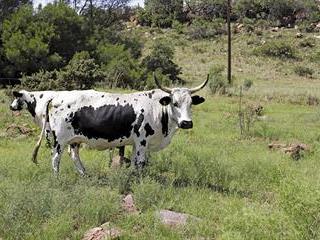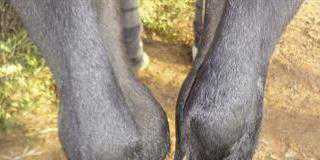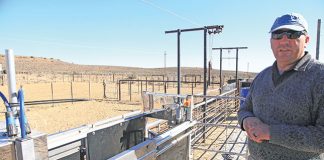
Peter Schultz farms Nguni x Red Angus cattle near Syferbult in North West. Previously, he had for 10 years farmed cattle near Enkeldoorn in what is now Zimbabwe. He usually weaned a calf crop of about 80%, and the missing 20% troubled him greatly.
“This had to be fixed, and is being fixed now. It is a well- accepted fact that the intercalving period (ICP) of a cow is an indication of her fertility, as well as that the fertility of a bull’s female offspring will mostly reflect the fertility of its dam,” says Peter, whose farm Belvedere, which is south-facing and mostly rocky, is situated south of the Magaliesberg mountains between Magaliesburg and Koster. It is an area of climatic extremes, from very hot days in summer to very cold – with heavy frost – in winter.
He runs a small herd of commercial beef cattle on the veld, with a Landmark protein lick year-round, in a low cost- weaner production system with neither a tractor nor implements.

Peter Schultz
Environment dictates type
“The cattle that have survived the rigours of Africa for centuries are small in stature,” explains Peter. “There is a lesson there for those who want to learn from it.”
He favours a crossbred or composite ranch-type cow. Simbras, Santas Gertrudis and other composite breeds are too large for the limited nutritional status of his veld, and he chose Nguni cattle for his dam line. The 32 commercial Nguni heifers that arrived on his farm in 2009 were born in 2008.
Favouring polled calves with good beef characteristics, Peter selected the Red Angus for the sire line. He saved Roger, his current bull, from a group of weaners destined for the feedlot in a purebred, but unregistered, herd of veld-reared cows.
“Never in the history of beef production has anyone had a greater reward from saving a bull from becoming T-bones,” Peter quips. ”I selected him primarily on his dam’s calving performance. He was born in May 2009 and his sister in August 2008. This gives an ICP of around 300 days.”
Environment- adapted cattle
Free State animal scientist, Dr JA Erasmus, wrote, “The sourveld is known for a long winter and vegetation of lower quality than that of the sweetveld. Cattle here should be of the Metabolic Type, which means compact, stocky, shorter on the leg.”
Peter says that this type, as described by Erasmus, “is typical of Roger’s daughters.”
In any environment, the correct size and type of cattle reproduce optimally on the veld, maximising their potential. Peter’s cattle are a typical example of this principle. “To borrow from Napoleon: a herd marches on its stomach. The grazing system determines the performance of veld-reared cattle.”
According to him, managing the veld wisely determines a herd’s productivity. “Constantly observe the veld with a critical eye and make adjustments where necessary. Be proactive rather than reactive.” Peter runs his herd in a seven- camp daily rotation grazing system with easy access to water and a daily allowance of fresh protein lick. “This keeps my cows happy, and happy cows are more fertile.”
With the grass growing actively, the cattle graze a camp for eight hours a day and are then moved to a small paddock for the remainder of the day. This cycle repeats itself every day, giving the grass time to grow. The system makes high production possible, even in mid-winter.
One of Peter’s cows, cow 8-71, will have her sixth consecutive July calf this year, with an average ICP of 369 to date.
Stable ICP figures
“I tried to impose a fixed breeding system, but my small herd refused to cooperate,” Peter recalls. “The cows took longer to adapt than I anticipated and calved from October 2010 to November 2011. When their second calves arrived – most of them in 2012 – the average ICP was poor.”
As the herd matured, the average ICPs generally improved and Peter started culling cows with long ICPs. The average age at first calving of Roger’s veld-reared heifers to date is 24 months and five days. Since 2013, the average ICP has been below 360 days/season. In 2014 and 2015, this was 340 days and 347 days respectively. The summer of 2013/2014 was wet and that of 2014/2015 dry.
“Nutritional conditions permitting, these figures are here to stay,” says Peter. “In 2014, 27 of the 30 calves were born within a 365 day period after the previous calves. This means that 90% of the cows calved twice in 365 days.”
Around 30% of the cows calved twice within 330 days (11 months) in 2014. Corresponding figures for 2015 were 79% in fewer than 365 days, and 28% in fewer than 330 days. In 2015, Cow 8-34 was the first to calve (12 January) and the last to calve in that year (30 November) for an ICP of 322 days.
“Roger’s dam had an ICP of around 300 days between his birth and that of his sister before him. His daughter 1A1 out of 8-34 was also the first to calve in 2014 (25 January) and last to calve (26 November), giving her an ICP of 305 days for that year.”
Peter adds that while experts maintain that the heritability of fertility is low, his four Nguna cows’ average ICPs, and Roger’s first four daughters from them (between 2013 and 2015), reveal that this may not necessarily be so. The average difference of about 20 days favours their daughters. Roger, the short-ICP bull, is a game changer. His daughters 1A1, 1A2, 1A3 and 1A4 have had 14 calves and 10 ICPs averaging 321 days.
How to shorten the ICP
Peter explains that the principle is to breed short-ICP bulls to short-ICP cows:
- Use a bull with a shorter ICP value than the breed average on the cows with the shortest ICPs in your herd;
- Stack a short ICP into the genotypes of every generation until they become the norm;
- A moderate calf birth weight allows the cow to recover after the calf is born and to reconceive quickly.
“My cows’ average gestation period is around 280 days; that of large breeds 290 days to 293 days. My cows have an advantage of approximately 14 days.”
He stresses that the long-term effect of hot, dry summers should encourage the move from larger to smaller and more easily maintained ranch cows. “It should also encourage a move from a high-cost beef production system (grazing plus stover, hay, silage and maize-based rations) to a low-cost (veld only) beef production system, ensuring a farmer a profit even when the beef price falls.
“Short ICPs in the sire line should be a priority in bull selection. Short ICPs are more important than any other characteristic being selected for. And, in any discussion about cows, the concept intercalving period should replace the word fertility. It is easy to define by numbers.
Peter explains that ICPs are easy to monitor, and a farmer dedicated to reducing ICPs will see results. “If a cattleman becomes committed to reducing the ICPs in a herd, it can lead to a radical improvement in the reproduction in any herd, whether stud, commercial or the national herd.”
To watch a video of Peter Schultz discussing his ICP principles, visit: ;













